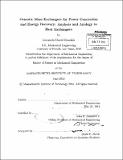| dc.contributor.advisor | John H. Lienhard V. | en_US |
| dc.contributor.author | Banchik, Leonardo David | en_US |
| dc.contributor.other | Massachusetts Institute of Technology. Department of Mechanical Engineering. | en_US |
| dc.date.accessioned | 2013-10-24T17:32:44Z | |
| dc.date.available | 2013-10-24T17:32:44Z | |
| dc.date.copyright | 2013 | en_US |
| dc.date.issued | 2013 | en_US |
| dc.identifier.uri | http://hdl.handle.net/1721.1/81592 | |
| dc.description | Thesis (S.M.)--Massachusetts Institute of Technology, Dept. of Mechanical Engineering, 2013. | en_US |
| dc.description | Cataloged from PDF version of thesis. | en_US |
| dc.description | Includes bibliographical references (p. 151-156). | en_US |
| dc.description.abstract | Desalination is an important separation process which can provide water scarce regions with clean water for drinking or for agricultural use. Thermal distillation has historically been the dominant method for obtaining pure water, but today, reverse osmosis (RO) produces a greater percentage of the total desalinated water worldwide by a large margin. Fundamentally, an RO system is a membrane-based osmotic mass exchanger. Another type of membrane-based osmotic process, a subset of forward osmosis (FO) called pressure retarded osmosis (PRO), currently exhibits promise for making desalination more energy efficient and is receiving attention in the literature. PRO exchangers are capable of producing power from two streams of different salinity and recovering energy from the brine stream of any desalination process when paired with water pumps and turbines. RO and PRO exchangers are essentially mass exchangers with a hydraulic or osmotic pressure difference across a membrane acting as the predominant driving potential. Using a simple resistance model for mass transfer applied across an ideal RO and PRO membrane, closed form expressions are developed which relate the performance of a one-dimensional membrane as a function of membrane properties, membrane area, inlet salinities, operating conditions, and flow configuration. These closed form expressions are analogous to the effectiveness versus number of transfer unit (c-NTU) models which have been used for decades in the rating and sizing of heat exchangers. The closed form expressions, along with numerical simulations for validating the models, are used to determine the limits of permeate flux in one-dimensional RO, PRO, and FO membranes; analyze the power performance of a one-dimensional PRO membrane; and determine the viability of using a PRO-based energy recovery device to reduce the net power consumption for RO desalination. The closed-form solutions for determining the performance of the RO and PRO membranes require that osmotic pressure be defined as a linear function of salinity. It is found that for a seawater RO process with a typical recovery ratio of 50% or less, the maximum error associated with linearization is less than 6.1%. For brackish water desalination, where processes typically operate at very high recovery ratios but have brine salinities lower than those encountered in seawater desalination, the error does not exceed 1.8%. For PRO membranes, using varying linearization curves, maximum errors for flux performance of less than 5.5% are incurred by the linear approximation. It is also found that the maximum Second Law efficiency of the power achievable from a one-dimensional PRO membrane is 66.48%. For large membrane areas, the maximum power for a PRO membrane occurs at a hydraulic pressure difference that is not equal to exactly one-half the osmotic pressure difference as reported in literature for zero-dimensional PRO membranes. For PRO membranes used for brine chemical energy recovery from an RO plant treating a feed stream of 35 g/kg, it is found that a wastewater salinity of less than 20 g/kg is required to recover power. Because the membranes within this study have been assumed as ideal, the performance results for flux, power, and power recovery can serve as informative upper bounds. | en_US |
| dc.description.statementofresponsibility | by Leonardo David Banchik. | en_US |
| dc.format.extent | 156 p. | en_US |
| dc.language.iso | eng | en_US |
| dc.publisher | Massachusetts Institute of Technology | en_US |
| dc.rights | M.I.T. theses are protected by
copyright. They may be viewed from this source for any purpose, but
reproduction or distribution in any format is prohibited without written
permission. See provided URL for inquiries about permission. | en_US |
| dc.rights.uri | http://dspace.mit.edu/handle/1721.1/7582 | en_US |
| dc.subject | Mechanical Engineering. | en_US |
| dc.title | Osmotic mass exchangers for power generation and energy recovery : analysis and analogy to heat exchangers | en_US |
| dc.type | Thesis | en_US |
| dc.description.degree | S.M. | en_US |
| dc.contributor.department | Massachusetts Institute of Technology. Department of Mechanical Engineering | |
| dc.identifier.oclc | 858863306 | en_US |
